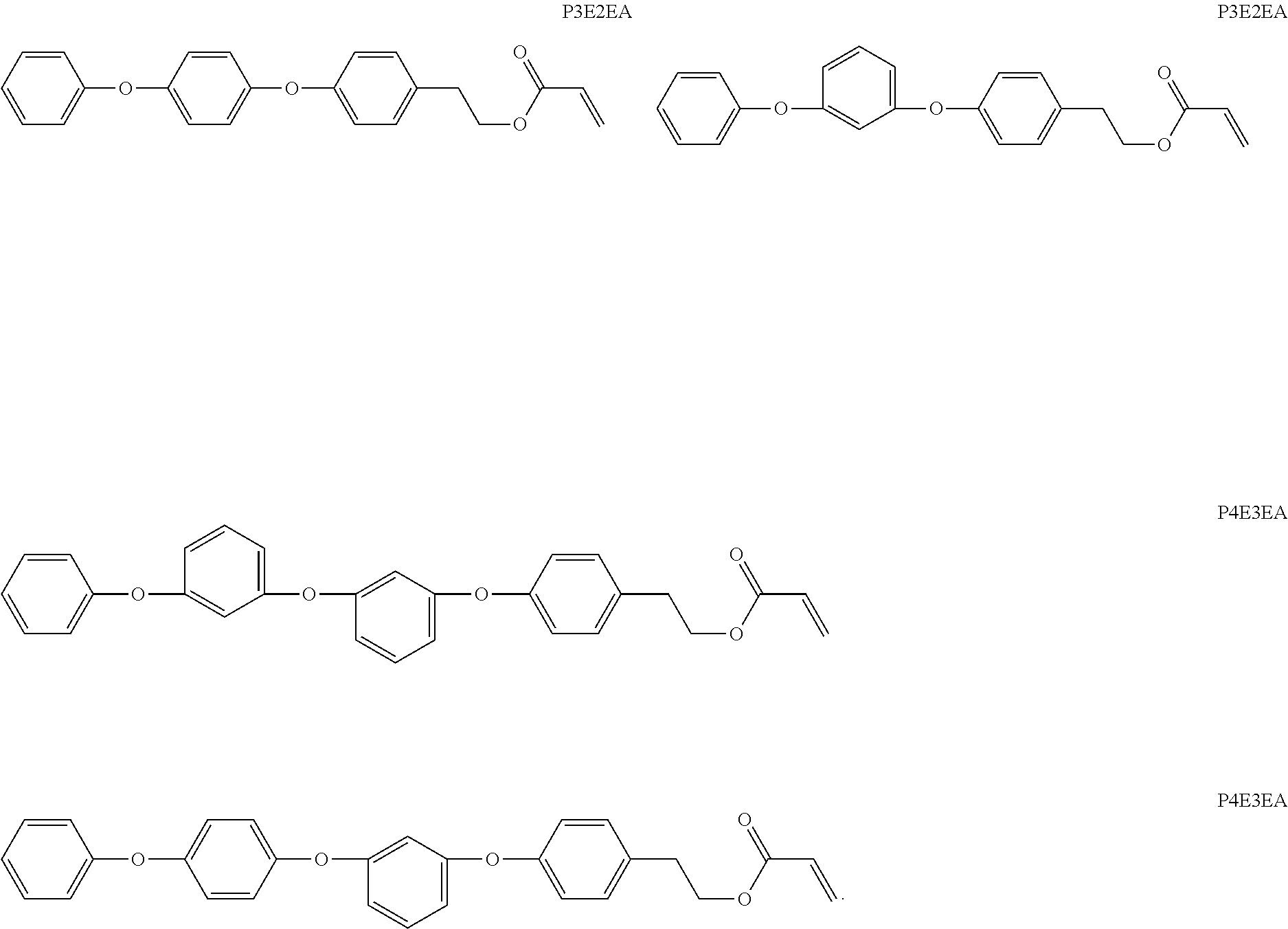Soft acrylic materials with high refractive index and minimized glistening
a soft acrylic and refractive index technology, applied in the field of soft acrylic materials with high refractive index and minimized glistening, can solve the problems of reducing the modulus and tensile strength of the resulting copolymer, known acrylic materials may have limited use as microincisions, etc., and achieves low equilibrium water content, efficient reduction or elimination, and high refractive index iols
- Summary
- Abstract
- Description
- Claims
- Application Information
AI Technical Summary
Benefits of technology
Problems solved by technology
Method used
Image
Examples
example 1
Synthesis of 2-[4-(4-phenoxyphenoxy)phenyl]ethanol
[0094]To a 1 L round bottom flask were charged 4-phenoxyphenol (95.0 g, 0.51 mol). THF (100 mL), sodium hydroxide (24 g, 0.6 mol), and DI water (80 mL). The mixture was magnetically stirred at room temperature for 30 minutes, followed by removal of solvent under reduced pressure. The white solid was then dried under vacuum (70 mTorr) at 150° C. overnight and cooled to room temperature. To the flask were then added 1-bromo-4-[2-(phenylmethoxy)ethyl]benzene (150 g, 0.51 mol) and anhydrous pyridine (100 mL). The mixture was purged with nitrogen for 15 minutes, followed by the addition of cuprous chloride (5 g, 0.05 mol). The mixture was then purge with nitrogen for additional 15 min and then sealed under nitrogen and magnetically stirred in a 130° C. oil bath for a week. After removal of pyridine under vacuum, the crude product was dissolved in methylene chloride (600 mL) and washed with 2N HCl (200 mL×3), 2N NaOH (200 mL×3). After remo...
example 2
Synthesis of 2-[2-(Benzyloxy)ethoxy]ethyl acrylate (DEGMBA)
[0096]To a 1 L three-neck round bottom flask equipped with mechanical stirrer were charged diethylene glycol monobenzyl ether (98.0 g, 0.5 mol), anhydrous triethylamine (120 mL, 0.85 mol), and anhydrous THF (300 mL). The solution was cooled in an ice / salt bath under dry air blanket for 15 minutes. Acryloyl chloride (55 mL, 0.68 mol) was added into the vigorously stirred cold solution through an addition funnel over 90 minutes and the addition rate was adjusted to keep the temperature of the reaction mixture below 10° C. After the addition, the reaction mixture was stirred in the ice / salt bath for additional two hours followed by quenching with the addition of 2M HCl (400 mL). The mixture was extracted with ethyl acetate (300 mL×3) and the combined organic layer was washed with DI water (200 mL×3), aqueous sodium bicarbonate (200 mL×2), and dried over MgSO4. Filtration and removal of solvents under reduced pressure gave the c...
example 3
[0097]The monomers from Examples 1 and 2 were formulated as shown in Table 1. Test samples measuring 0.9 mm in thickness were blue light cured at 55° C. for 1 hour. Samples were extracted in acetone for 20 hours at 55° C. and then dried slowly at ambient temperature for 20 hours, followed by vacuum (0.1 mm Hg) for a minimum of 20 hours at 70° C.
[0098]
TABLE 1EXAMPLE (% w / w)Component44B44E54CP3E2EA51.4566.66—P4E3EA——66.66DEGMBA45.2025.0024.99PolyPEGMA—4.995.00BDDA1.551.501.51oMTP1.761.801.80Blue Blocker0.040.040.04Irgacure 8190.210.300.32PTEA = 2-(phenylthio)ethyl acrylatePTEMA = 2-(phenylthio)ethyl methacrylateBDDA = 1 ,4-butanediol diacrylatepolyPEGMA = methacrylate terminated polymer with Mn = 3,900 derived from PEG (350) monomethyl ether methacrylateoMTP = 2-(2H-benzo[d][1 ,2,3]triazol-2-yl)-4-methyl-6-(2-methylallyl)phenolBlue blocker = N-[2-[4-hydroxy-3-[2-(2-methylphenyl)diazenyl]phenyl]ethyl]methacryamideIrgacure 819 = phenylbis (2,4,6-trimethylbenzoyl)phos...
PUM
| Property | Measurement | Unit |
|---|---|---|
| temperature | aaaaa | aaaaa |
| refractive index | aaaaa | aaaaa |
| elongation | aaaaa | aaaaa |
Abstract
Description
Claims
Application Information
 Login to View More
Login to View More - R&D
- Intellectual Property
- Life Sciences
- Materials
- Tech Scout
- Unparalleled Data Quality
- Higher Quality Content
- 60% Fewer Hallucinations
Browse by: Latest US Patents, China's latest patents, Technical Efficacy Thesaurus, Application Domain, Technology Topic, Popular Technical Reports.
© 2025 PatSnap. All rights reserved.Legal|Privacy policy|Modern Slavery Act Transparency Statement|Sitemap|About US| Contact US: help@patsnap.com



